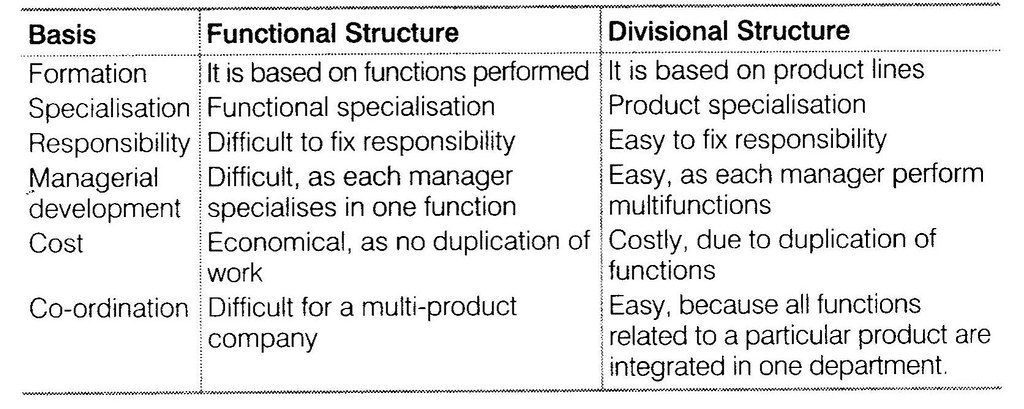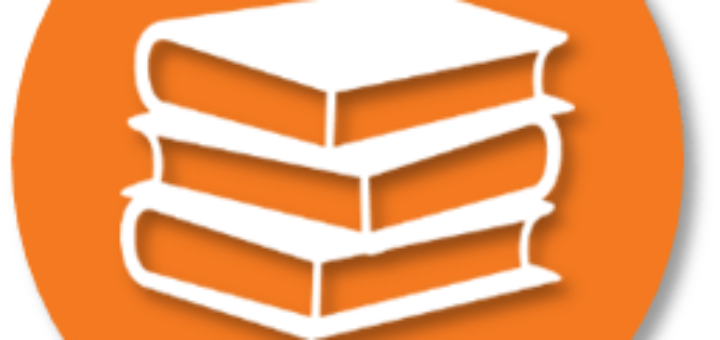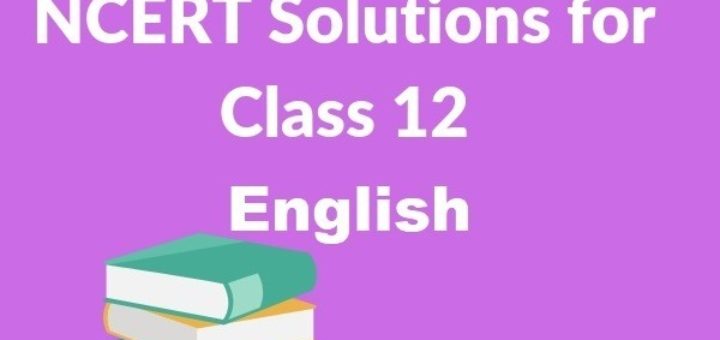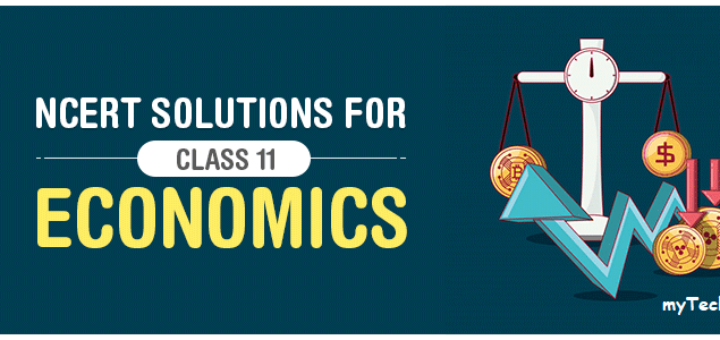Short Answer Type Questions
1. Define ‘Organising?
Ans: Organising is defined as a process that initiates implementation
of plans by clarifying jobs, working relationships and effectively deploying
resources for attainment of identified and desired results.
2. What are the steps in the process of organising?
Ans: Organising involves following steps that need to be taken in series
(i) Identification and Division of Work Organising process begins with identifying and division of total work into small units.
(ii) Departmentalisation After dividing the work, related and similar jobs are grouped together and put under one department.
(iii) Assignment of Duties After departmentalisation, the work is assigned according to the ability of individuals.
(iv) Establishing Reporting Relationship Assigning duties is not enough. Each individual should also know, who he has to take orders and to whom he is accountable. Thus, reporting relationship helps in co-ordination among various departments.
3. Discuss the elements of delegation.
Ans: The elements of delegation are as follows
(i) Authority It refers to the right of an individual to command his subordinates and to take action within the scope of his position. The concept of authority arises from the established scalar chain, which links the various job positions and levels of an organisation. It must be noted that authority is restricted by laws and the rules and regulations of the organisations. Authority flows downward.
(ii) Responsibility Responsibility is the obligation of a subordinate to properly perform the assigned duty. It arises from a superior-subordinate relationship because the subordinate is bound to perform the duty assigned to him by his superior. Responsibility flows upward.
(iii) Accountability Accountability implies being answerable for the final outcome. Once authority has been delegated and responsibility accepted, one cannot deny accountability. It cannot be delegated and flows upwards i.e., a subordinate will be accountable to a superior for satisfactory performance of work.
4. What does the term ‘Span of management’ refer to?
Ans: Is the number of subordinates under a superior or we can say, it means how many employees can be effectively managed by a superior. The span of management, to a large extent gives shape to the organisational structure, e.g., if the number of subordinates under a superior keep increasing when we move downward then the shape of the organisational structure will be as follows.
5. Under what circumstances would functional structure prove to be an appropriate choice?
Ans: Functional structure would prove to be most suitable when the size of the organisation is large, has diversified activities and operations require a high degree of specialisation. It promotes control and co-ordination within a department, increased managerial and operational efficiency, results in increased profits.
6. Draw a diagram depicting a divisional structure.
7. Can a large sized organisation be totally centralised or decentralised? Give your opinion.
Ans: No large organisation can not be totally centralised or decentralised. Complete centralisation would imply concentralisation of all decision making functions at the apex of the management hierarchy. Such a scenario would obviate the need for a management hierarchy. On the other hand, complete decentralisation would imply the delegation of all decision making functions to the lower level of the hierarchy and this would finish off the need for higher, managerial positions. Both the situations are unrealistic.
As an organisation grows in size and complexity, there is a tendency to move towards decentralised decision making. This is because, in large organisations those employees, who are directly and closely involved with certain operations tend to have more knowledge about them than the top management, which may only be indirectly associated with individual operations. Hence, there is a need for balance between these co-existing forces.
8. Decentralisation is extending delegation to the lowest level. Comment.
Ans: Decentralisation is extending delegation to the lowest level. Decentralisation explains the manner in which decision making responsibilities are divided among hierarchical levels. Decentralisation refers to delegation of authority throughout all the levels of the organisation. Decision making authority is shared with lower levels and is consequently placed nearest to the point of action. In other words, decision making authority is pushed down the chain of command. Delegation is the process and decentralisation is the end result, e.g., If the director give the responsibility to production head to complete the target of 20,000 units and authorise him to hire the workers, production head further shares his responsibility with manager to select the worker. Manager shares his responsibility with supervisors, who are dealing with workers, authorise him to select workers. Here, the responsibility distributed at every level. That’s why we say systematic delegation leads to decentralisation.
Long Answer Type Questions
1. Why is delegation considered essential for effective organising?
Ans: Effective delegation leads to the following benefits
(i) Effective Management By empowering the employees, the managers are able to function more efficiently as they get more time to concentrate on important matters. This makes the working of all the levels effective and efficient.
(ii) Employee Development As a result of delegation, employees get more opportunities to utilise their talent and this may give rise to talent abilities in them. It makes them better leaders and decision makers. Delegation empowers the employees by providing them with the chance to use their skills, gain experience and develop themselves for higher positions.
(iii) Motivation of Employees Delegation helps in developing the talents of the employees. It also has psychological benefits. Responsibility for work builds the self-esteem of an employee and improves his confidence. He feels encouraged and tries to improve his performance further.
(iv) Facilitation of Growth Delegation helps in the expansion of an organisation by providing a ready workforce to take up leading positions in new ventures. Trained and experienced employees are able to play significant roles in the launch of new projects.
(v) Basis of Management Hierarchy Delegation of authority establishes superior-subordinate, which are the basis of hierarchy of management. The extent of delegated authority also decides the power that each job position enjoys in the organisation.
(vi) Better Co-ordination Due to delegation work, duties, power all becomes very clear. This helps to avoid overlapping of duties and duplication of effort as it gives a clear picture of the work being done at various levels. Such clarity in reporting relationships help in developing and maintaining effective coordination amongst the departments, levels and functions of management.
2. What is a divisional structure? Discuss its advantages and limitations.
Ans: A divisional structure comprises of separate business units or divisions. Each unit has a divisional manager responsible for performance and who has authority over the unit. Generally, manpower is grouped on the basis of different products manufactured.
Merits
(i) Skill Development Product specialisation helps in the development of varied skills in a divisional head and this prepares him for higher positions as he gains experience in all functions.
(ii) Accountability Divisional heads are accountable for profits, as revenues and costs related to different departments, can be easily identified and assigned to them. This provides proper basis for performance measurement.
(iii) Quick Decision Making It promotes flexibility and initiative because each division functions as an autonomous unit which leads to faster decision making.
(iv) Facilitates Expansion It facilitates growth as new divisions can be added without interrupting the existing operations, by merely adding another divisional head and staff for the new product line.
Demerits
The divisional structure has certain disadvantages
(i) Conflicts Conflicts may arise among different divisions with reference to allocation of funds.
(ii) Higher Cost Providing each division with separate set of similar functions increases expenditure.
(iii) Ignoring Organisational Goals It provides managers with the authority to supervise all activities related to a particular division. In course of time, such a manager may gain power and in a bid to assert his independence may ignore organisational interests.
3. Decentralisation is an optional policy. Explain why an organisation would choose to be decentralised.
Ans: Decentralisation is much more than mere transfer of authority to the lower levels of management hierarchy. Its importance can be understood from the following points
(i) Develops Initiative Among Subordinates When lower managerial levels are given freedom to take their own decisions they learn to depend on their judgement. A decentralised policy helps to identify those executives, who have the necessary potential to become dynamic leaders.
(ii) Develops Managerial Talent for the Future Formal training plays an important part in equipping subordinates with skills that help them rise in the organisation, but equally important is the experience gained by handling assignments independently. It gives them a chance to prove their abilities and creates a reservoir of qualified manpower.
(iii) Quick Decision Making In a decentralised organisation, however, since decisions are taken at levels, which are nearest to the points of action and there is no requirement for approval from many levels the process is much faster.
(iv) Relief to Top Management Decentralisation leaves the top management with more time, which they can devote to important policy decisions rather than occupying their time with both policy as well as operational decisions.
(v) Facilitates Growth Decentralisation awards greater autonomy to the lower levels of management as well as divisional or departmental heads. This allows them to function in a manner best suited to their department and develops a sense of competition amongst the departments, consequently, the productivity levels increase and the organisation is able to generate more returns, which can be used for expansion purposes.
(vi) Better Control Decentralisation makes it possible to evaluate performance at each level and the departments can be individually held accountable for their results. The extent of achievement of organisational objectives as well as the contribution of each department in meeting, the over all objectives can be ascertained
4. How does informal organisation support the formal organisation?
Ans: The informal organisation offers many benefits. Important among them are given as follows
(i) Quick Feedback Prescribed lines of communication are not followed. Thus, the informal organisation leads to faster spread of information as well as quick feedback.
(ii) Social Needs It helps to fulfill social needs of the members and allows them to find like minded people. This enhances their job satisfaction, since it gives them a sense of belongingness in the organisation.
(iii) Organisational Objectives It contributes towards fulfilment of organisational objectives by compensating for inadequacies in the formal organisation e.g., feedbacks on new policies etc can be tested through informal network.
5. Distinguish between centralisation and decentralisation.
Ans: Difference between centralisation and decentralisation.
6. How is a functional structure different from a divisional structure?
Ans: Difference between functional and divisional structure
Application Type Questions
1. Neha runs a factory wherein she manufactures shoes. The business has been doing well and she intends to expand by diversifying into leather bags as well as Western formal wear, thereby making her company a complete provider of corporate wear. This will enable her to market her business unit as the one stop for working women. Which type of structure would you recommend for her expanded organisation and why?
Ans: Neha should decide for divisional structure because
(i) She will diversify her unit now into varied product lines.
(ii) Such a structure would enable her to know the profit margins from each product line and accordingly, she can plan and select the specific product for future diversification.
(iii) It will facilitate further expansion without disturbing the existing units.
2. The production manager asked the foreman to achieve a target production of 200 units per day, but he doesn’t give him the authority to requisition tools and materials from the stores department. Can the production manager blame the foreman if he is not able to achieve the desired target? Give reasons.
Ans: No, the production manager cannot hold the foreman responsible for the incomplete work as the foreman was not given authority by the manager. The principle of authority responsibility says that there should be a balance between the authority and responsibility. If the authority given is more, then it leads to misuse of authority and if responsibility is more, then the work will not be completed.
3. A manager enhances the production target from 500 units to 700 units per month, but the authority to draw raw material was not given by him. The production manager could not achieve the revised production target. Who is responsible and which principle was violated?
Ans: The manager is responsible for work not being completed. The principle of authority responsibility is violated.
4. A company has its registered office in Delhi, manufacturing unit at Gurgaon and marketing and sales department at Faridabad. The company manufactures the consumer products. Which type of organisational structure should it adopt to achieve its target?
Answer
(i) As a company is performing separate functions in separate areas, then it should adopt functional structure.
(ii) The services of experts are common to all products. It will be economical as no duplication will take place.
(iii) Span of management can be increased as workers will be doing same type of work.
Case Problems
1. A company, which manufactures a popular brand of toys, has been enjoying good market reputation. It has a functional organisational structure with Separate departments for production, marketing, finance, human resources and research and development.
Lately to use its brand name and also to cash on to new business opportunities it is thinking to diversify into manufacture of new range of electronic toys for which a new market is emerging.
Question Prepare a report regarding organisation structure giving concrete reasons with regard to benefits the company will derive from the steps it should take.
Ans: In the given situation, organisation should shift from functional structure to divisional structure as the company wants to diversify; by adding a new product line. The reasons and benefits are
(i) The performance of each unit can be easily assessed.
(ii) New product lines can be easily added without disturbing the existing units.
(iii) Decision making is faster.
(iv) Divisional structure maintains short line of communication with customers and provide better services to them.
2. A company manufacturing sewing machines set up n 1945 by the British promoters follows formal organisation culture in totality. It is facing lot of problems in delays in decision making. As the result it is not able to adapt to changing business environment. The work force is also not motivated since they cannot vent their grievances except through formal channels, which involve red tape. Employee turnover is high. Its market share is also declining due to changed circumstances and business environment.
Question You are to advise the company with regard to change it should bring about its organisation structure to overcome the problems faced by it. Give reasons in terms of benefits it will derive from the changes suggested by you. In which sectors can the company diversify, keeping in mind the declining market for the product the company is manufacturing?
Ans: The suggestions are
(i) To overcome the limitations of formal organisation, the management should encourage workers to interact and socialise with each other through get together outings. In this way, everyone will interact and like minded people will come closer. The net result will be more satisfied workforce.
(ii) The management should try to decentralise organisation structure.
(iii) The suggested area where the business can be diversified is textile machineries like embroidery units, sequencing units, buttoning units.
3. A company X limited manufacturing comsetics, which has enjoyed a pre-eminent position in business, has grown in size. Its business was very good till 1991. But after that, new liberalised environment has seen entry of many MNC’s in the sector.
With the result the market share of X limited has declined. The company had followed a very centralised business model with directors and divisional heads making even minor decisions. Before 1991, this business model had served the company very well as consumers has no choice. But now the company is under pressure to reform.
Question What organisation structure changes should the company bring about in order to retain its market share?
How will the changes suggested by you help the firm? Keep in mind that the sector in which the company is FMCG.
Ans: The company X Ltd is working in a centralised way, which is not giving enough time to the higher officials to think of better policies, strategies to handle the changes in the changing environment. The company should thus get decentralised so that the routine type of work, involving minor decisions can be looked after by the lower levels. This will give/save more time for the directors and divisional heads to plan strategies to fight with competition.







